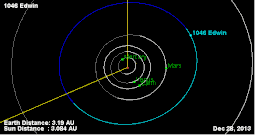1046 Edwin
1046 Edwin, provisional designation 1924 UA, is a background asteroid from the outer regions of the asteroid belt, approximately 30 kilometers (20 miles) kilometers in diameter. It was discovered on 1 December 1924, by Belgian–American astronomer George Van Biesbroeck at the Yerkes Observatory in Wisconsin, United States, who named it after his son, Edwin Van Biesbroeck.[1] The potentially metallic asteroid has a short rotation period of 5.29 hours.[4]
 Orbital diagram of 1046 Edwin | |
| Discovery [1] | |
|---|---|
| Discovered by | G. van Biesbroeck |
| Discovery site | Yerkes Obs. |
| Discovery date | 1 December 1924 |
| Designations | |
| (1046) Edwin | |
Named after | Edwin Van Biesbroeck [2] (discoverer's son) |
| 1924 UA · 1949 RB 1949 YL | |
| main-belt [1][3] · (outer) [4] background [5] | |
| Orbital characteristics [3] | |
| Epoch 23 March 2018 (JD 2458200.5) | |
| Uncertainty parameter 0 | |
| Observation arc | 91.86 yr (33,553 d) |
| Aphelion | 3.1769 AU |
| Perihelion | 2.7895 AU |
| 2.9832 AU | |
| Eccentricity | 0.0649 |
| 5.15 yr (1,882 d) | |
| 53.846° | |
| 0° 11m 28.68s / day | |
| Inclination | 7.8991° |
| 10.745° | |
| 47.898° | |
| Physical characteristics | |
Mean diameter | 25.15±0.66 km[6] 29.084±0.405 km[7] 36.355±0.604 km[8] 42.23 km (calculated)[4] |
| 5.29±0.01 h[9][lower-alpha 1] 5.2906±0.0001 h[10] 5.296±0.006 h[10] 5.30±0.02 h[11] | |
| 0.057 (assumed)[4] 0.1113±0.0145[8] 0.201±0.039[7] 0.235±0.014[6] | |
| SMASS = Xe [3] · M [8] | |
| 10.20[6][8] · 10.6[3][4] 11.08±0.29[12] | |
Orbit and classification
Edwin is a non-family asteroid from the main belt's background population.[5] It orbits the Sun in the outer asteroid belt at a distance of 2.8–3.2 AU once every 5 years and 2 months (1,882 days; semi-major axis of 2.98 AU). Its orbit has an eccentricity of 0.06 and an inclination of 8° with respect to the ecliptic.[3] The body's observation arc begins with its first recorded observation at Heidelberg Observatory in March 1926, or 15 months after its official discovery observation at Yerkes Observatory.[1]
Physical characteristics
In the SMASS classification, Edwin is an Xe-subtype that transitions from the X-type to the very bright E-type asteroid [3] It has also been characterized as a metallic M-type asteroid by the Wide-field Infrared Survey Explorer (WISE).[8]
Rotation period
Since 2001, several rotational lightcurves of Edwin have been obtained from photometric observations by American William Koff at the Antelope Hills Observatory (H09) in Colorado,[9][lower-alpha 1] Richard Ditteon at the Oakley Observatory in Indiana,[11] and French amateur astronomers Pierre Antonini, René Roy and Stéphane Charbonnel.[10]
Analysis of the best-rated lightcurve by Pierre Antonini from November 2006, gave a rotation period of 5.2906 hours with a brightness amplitude of 0.27 magnitude (U=3).[4][10] While not being a fast rotator, it has a relatively short spin-rate for an asteroid of its size.
Diameter and albedo
According to the surveys carried out by the Japanese Akari satellite and the NEOWISE mission of NASA's WISE telescope, Edwin measures between 25.15 and 36.355 kilometers in diameter and its surface has an albedo between 0.1113 and 0.235.[6][7][8]
The Collaborative Asteroid Lightcurve Link assumes a standard albedo for carbonaceous asteroids of 0.057 and consequently calculates a larger diameter of 42.23 kilometers based on an absolute magnitude of 10.6.[4]
Naming
This minor planet was named after Edwin Van Biesbroeck, son of discoverer George Van Biesbroeck. The official naming citation was mentioned in The Names of the Minor Planets by Paul Herget in 1955 (H 99).[2]
Notes
- Lightcurve plot of (1046) Edwin by Robert A. Koff at the Antelope Hills Observatory.[9] Rotation period 5.29±0.01 hours. Quality code of 2+.
References
- "1046 Edwin (1924 UA)". Minor Planet Center. Retrieved 20 March 2018.
- Schmadel, Lutz D. (2007). "(1046) Edwin". Dictionary of Minor Planet Names. Springer Berlin Heidelberg. p. 89. doi:10.1007/978-3-540-29925-7_1047. ISBN 978-3-540-00238-3.
- "JPL Small-Body Database Browser: 1046 Edwin (1924 UA)" (2018-01-26 last obs.). Jet Propulsion Laboratory. Retrieved 20 March 2018.
- "LCDB Data for (1046) Edwin". Asteroid Lightcurve Database (LCDB). Retrieved 20 March 2018.
- "Asteroid 1046 Edwin – Nesvorny HCM Asteroid Families V3.0". Small Bodies Data Ferret. Retrieved 24 October 2019.
- Usui, Fumihiko; Kuroda, Daisuke; Müller, Thomas G.; Hasegawa, Sunao; Ishiguro, Masateru; Ootsubo, Takafumi; et al. (October 2011). "Asteroid Catalog Using Akari: AKARI/IRC Mid-Infrared Asteroid Survey". Publications of the Astronomical Society of Japan. 63 (5): 1117–1138. Bibcode:2011PASJ...63.1117U. doi:10.1093/pasj/63.5.1117. Retrieved 20 March 2018. Online catalog
- Masiero, Joseph R.; Grav, T.; Mainzer, A. K.; Nugent, C. R.; Bauer, J. M.; Stevenson, R.; et al. (August 2014). "Main-belt Asteroids with WISE/NEOWISE: Near-infrared Albedos". The Astrophysical Journal. 791 (2): 11. arXiv:1406.6645. Bibcode:2014ApJ...791..121M. doi:10.1088/0004-637X/791/2/121.
- Mainzer, A.; Grav, T.; Masiero, J.; Hand, E.; Bauer, J.; Tholen, D.; et al. (November 2011). "NEOWISE Studies of Spectrophotometrically Classified Asteroids: Preliminary Results". The Astrophysical Journal. 741 (2): 25. arXiv:1109.6407. Bibcode:2011ApJ...741...90M. doi:10.1088/0004-637X/741/2/90.
- Koff, R. A. (June 2002). "Lightcurve Photometry of 492 Gismonda, 1046 Edwin, and 1310 Villigera". The Minor Planet Bulletin. 29: 25–26. Bibcode:2002MPBu...29...25K.
- Behrend, Raoul. "Asteroids and comets rotation curves – (1046) Edwin". Geneva Observatory. Retrieved 20 March 2018.
- Ditteon, Richard; Hawkins, Scot (September 2007). "Asteroid Lightcurve Analysis at the Oakley Observatory - October-November 2006". The Minor Planet Bulletin. 34 (3): 59–64. Bibcode:2007MPBu...34...59D. ISSN 1052-8091.
- Veres, Peter; Jedicke, Robert; Fitzsimmons, Alan; Denneau, Larry; Granvik, Mikael; Bolin, Bryce; et al. (November 2015). "Absolute magnitudes and slope parameters for 250,000 asteroids observed by Pan-STARRS PS1 - Preliminary results". Icarus. 261: 34–47. arXiv:1506.00762. Bibcode:2015Icar..261...34V. doi:10.1016/j.icarus.2015.08.007.
External links
- Asteroid Lightcurve Database (LCDB), query form (info)
- Dictionary of Minor Planet Names, Google books
- Asteroids and comets rotation curves, CdR – Observatoire de Genève, Raoul Behrend
- Discovery Circumstances: Numbered Minor Planets (1)-(5000) – Minor Planet Center
- 1046 Edwin at AstDyS-2, Asteroids—Dynamic Site
- 1046 Edwin at the JPL Small-Body Database
